How to Get Yellow Out of Gray Hair and Make It Gracefully Radiant
Updated on
This post may contain affiliate links. As an Amazon Associate, we may earn from qualifying purchases.
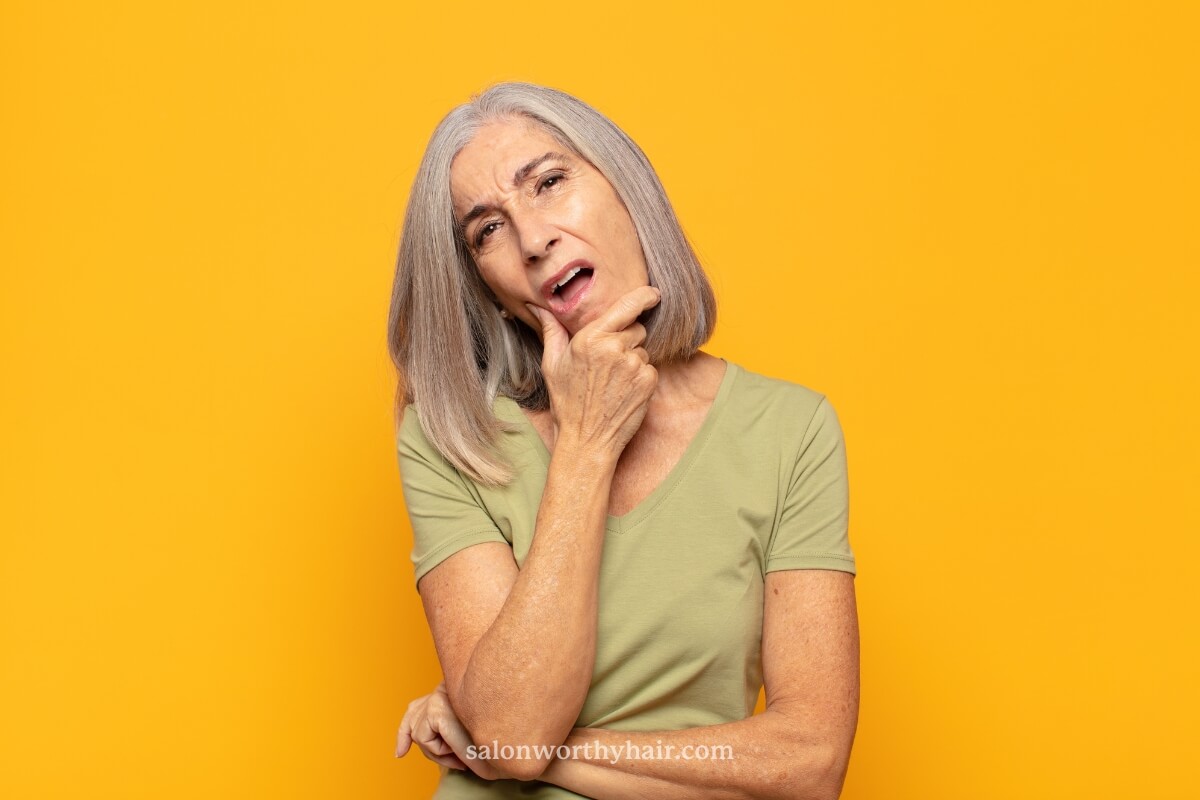
As we age, our hair naturally starts to turn gray. While some people embrace this change, others may find it to be a bit of a challenge.
One of the most common complaints about gray hair is that it can sometimes take on a yellow tint. This can be due to a number of factors, including exposure to sunlight, hard water, and even certain hair products.
Luckily, there are easy ways to fix it and make your hair look brighter and more vibrant.
Let me show you how to get yellow out of gray hair with easy to follow methods you can try at home.
Let’s get started …
Use Purple Shampoo
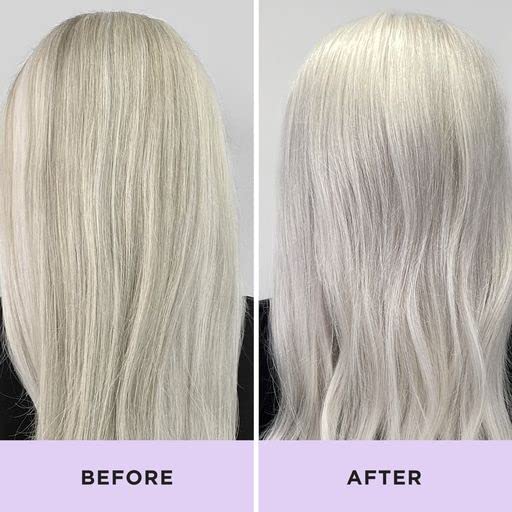
Results from Jhirmack Silver Plus Ageless Shampoo – Amazon.com
Purple shampoo is specifically formulated to tone down yellow or brassy tones in blonde and gray hair tones by neutralizing them with violet pigments. When applied to gray hair, the purple pigments in the shampoo neutralize the unwanted yellow tones, making gray hair look brighter and cooler.
This theory is based on the hair color wheel, where purple (or violet) sits opposite to yellow, meaning purple cancels out yellow and orange tones when mixed together.
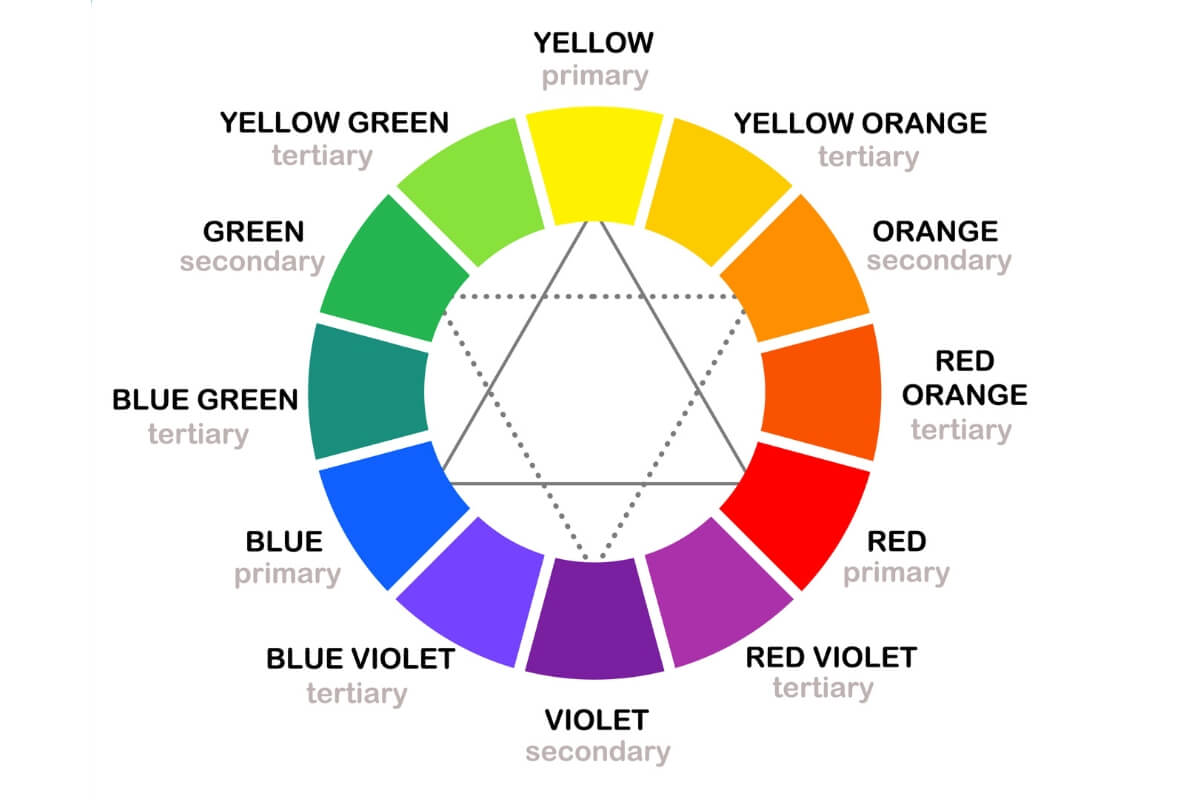
However, it is important to note that purple shampoo does not remove the yellow color from gray hair but rather is a temporary solution to tone down the yellow.
Here’s how to use purple shampoo to cancel out yellow shades in gray hair:
Wet your hair: Before applying the purple shampoo, wet your hair thoroughly with lukewarm water. This will help the shampoo to spread evenly and work effectively on your hair.
- Apply the purple shampoo: Pour a sufficient amount of purple shampoo onto your palm, depending on your hair length and thickness. Gently massage the shampoo into your hair, focusing on the areas with the most noticeable yellow tones. Be sure to distribute the shampoo evenly throughout your hair, from roots to ends.
- Let it sit: Allow the purple shampoo to sit on your hair for the recommended time mentioned on the product label. Typically, this ranges from 3-5 minutes for a subtle toning effect to 10-15 minutes for a stronger effect. The longer you leave the shampoo in your hair, the more intense the neutralizing action will be. However, be cautious not to leave it on for too long, as it may cause over-toning and leave a purple tint on your hair.
- Rinse thoroughly: After the recommended time has passed, rinse your hair thoroughly with lukewarm water until the water runs clear. Make sure to remove all the shampoo residue from your hair.
- Condition your hair: Purple shampoos can be slightly drying, so it’s essential to follow up with a moisturizing conditioner/purple conditioner or hair mask, especially for gray hair, which tends to be drier and more fragile. Apply the conditioner or mask from mid-lengths to the ends, avoiding the roots. Let it sit for a few minutes, then rinse thoroughly.
- Style as usual: Gently towel dry your hair and proceed with your regular styling routine. You can use a heat protectant spray, serums, or leave-in conditioners to help protect and nourish your hair.
To maintain the neutralized yellow tones in your gray hair, use purple shampoo once or twice a week or as needed, depending on your hair’s condition and desired tone.
Always follow the instructions on the product label and consult a professional stylist if you have any concerns.
Use a Silver Shampoo for Removing Stubborn Yellow Tones
Silver shampoo is formulated with stronger purple pigments than purple shampoo. This makes it more effective at removing stubborn yellow tones.
Ultimately, the best way to choose between silver shampoo and purple shampoo is to consider the severity of the yellowing in your hair and the condition of your hair. If you have severe yellowing, silver shampoo is a better choice. Purple shampoo is a better choice if you have dry or damaged hair.
Here is a table that summarizes the key differences between purple and silver shampoos:
Silver shampoo vs. Purple Shampoo for Yellowing Gray Hair.
| Feature | Silver Shampoo | Purple shampoo |
|---|---|---|
| Strength of purple pigments | Stronger | Weaker |
| Gentleness on hair | Less gentle | More gentle |
| Best for | Severe yellowing | Dry or damaged hair |
Use a Clarifying Shampoo
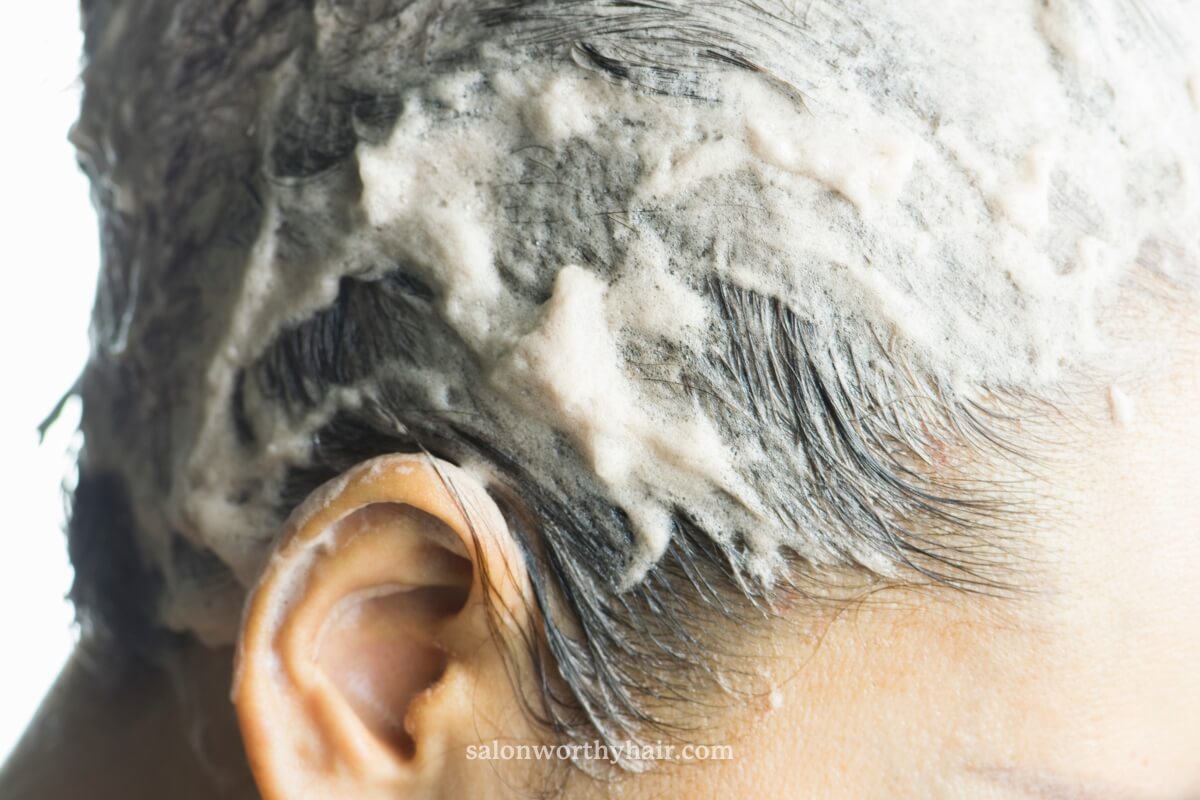
A clarifying shampoo can neutralize yellow tones in gray hair through a combination of its deep-cleansing properties and specific color-balancing ingredients. Gray hair can develop brassy or yellow tones due to various factors such as pollution, hard water, smoking, and the natural oxidation process.
Here’s a detailed breakdown of how clarifying shampoos work to neutralize these tones:
- Deep-cleansing properties:
- Clarifying shampoos are designed to remove product build-up, excess oils, and impurities from the hair. These shampoos contain stronger surfactants, which are the cleaning agents responsible for breaking down and washing away dirt and grime. By effectively removing the build-up of minerals, pollutants, and other residues, clarifying shampoos help restore the hair’s natural color and shine, reducing the appearance of yellow tones.
- Color-balancing ingredients:
- Some clarifying shampoos are formulated with specific color-balancing agents, such as violet or blue pigments. These pigments work on the principle of color theory, where complementary colors neutralize each other. In the case of gray hair with yellow tones, the violet or blue pigments in the shampoo will counteract and neutralize the yellow color, resulting in a more silver or neutral gray shade.
- pH-balancing properties:
- The hair’s natural pH level is slightly acidic, which helps to maintain its integrity and color. Some external factors, such as hard water, can disrupt the hair’s pH balance, leading to color changes and yellowing. Clarifying shampoos often have pH-balancing properties that restore the hair’s natural acidity, further helping to neutralize unwanted tones and promote a healthy, vibrant color.
- Enhanced hair health:
- By removing the build-up of impurities and balancing the hair’s pH levels, clarifying shampoos contribute to healthier hair. Healthier hair is less prone to color changes and yellowish tones, as it can better resist external factors that contribute to hair discoloration.
How to use a clarifying shampoo to remove yellow tones from gray hair:
- Wet your hair thoroughly with warm water.
- Apply a quarter-sized amount of clarifying shampoo to your scalp.
- Massage your scalp gently, working the shampoo through your hair.
- Let the shampoo sit on your hair for 3-5 minutes.
- Rinse your hair thoroughly with cool water until the water runs clear.
- Apply a hydrating conditioner to your hair, focusing on the ends.
- Leave the conditioner on for 2-3 minutes, then rinse your hair thoroughly with cool water.
- Towel-dry your hair gently, making sure not to rub it too vigorously.
It’s recommended to use them only once every week. If you find that your hair is becoming dry or brittle, you may want to use a deep conditioning treatment after using a clarifying shampoo to help restore moisture and shine to your hair.
Also, use a clarifying shampoo specifically designed for this purpose. Regularly using such a shampoo and proper hair care practices can help maintain the desired gray shade and keep the hair looking vibrant and healthy.
Use Apple Cider Vinegar

Apple cider vinegar (ACV) is acidic in nature, which helps to balance the pH of the hair. When hair becomes too alkaline, it can lead to cuticle damage, which can cause hair to look dull, dry, and yellow. Apple cider vinegar has a pH level of around 3, which is closer to the natural pH of hair, helping to restore the hair’s natural acidity. The natural bleaching agent in apple cider vinegar also helps to combat unwanted yellow tones to whiten gray hair.
When applied to hair, apple cider vinegar helps break down the build-up of product and sebum on the scalp, which can contribute to yellowing. The acidic elements in apple cider vinegar help to remove this buildup and restore the scalp’s natural pH, promoting healthy hair growth.
Here’s how to use apple cider vinegar to neutralize yellow tones:
- Mix a solution of half water and half apple cider vinegar in a spray bottle.
- Wash your hair with a gentle shampoo and rinse thoroughly.
- Apply the apple cider vinegar solution to your wet hair, focusing on the yellow areas.
- Leave the solution in your hair for 10-15 minutes. You can use a shower cap to cover your hair and help the solution penetrate better.
- Rinse with cool water.
- Condition your hair as usual, focusing on the ends.
- Style your hair as you normally would.
Visit a Hairdresser
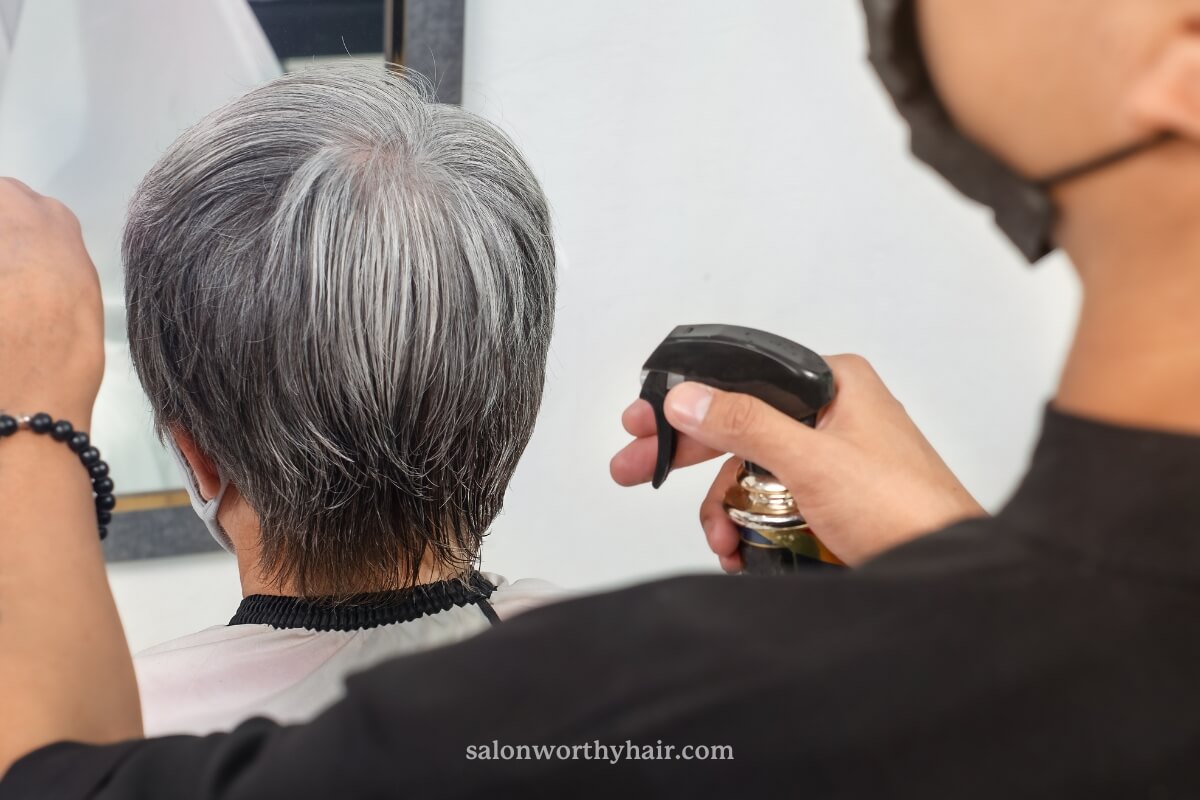
Your hairdresser can recommend the best products and treatments for your hair type. They can also help you choose the right color and intensity of purple shampoo or toner.
Ask your hairdresser about the different methods that they can use to remove yellowing. Many different methods can be used, and the best method for you will depend on your hair type and the severity of the yellowing.
Your hairdresser can also help you avoid over-processing your hair. They can also recommend products and treatments to help keep your hair healthy and hydrated.
Why Does Gray Hair Turn Yellow?
Gray hair can turn yellow due to age-related loss of melanin, excessive heat styling, environmental pollutants like chlorine and minerals, and the use of hair styling products. These factors make hair more porous and prone to picking up pigments from its surroundings, resulting in yellowing.
Let’s take a look closely at the various causes of yellowing in gray hair:
Aging
Gray hair turning yellow is a natural part of the aging process, and it is primarily influenced by the decline in melanin production within our hair follicles. Melanin, a pigment responsible for the color of our hair, skin, and eyes, comes in eumelanin (black or brown) and pheomelanin (yellow or red). As we grow older, melanocytes, the cells that produce melanin, become less active and, eventually, stop producing melanin altogether. This gradual decline in melanin production results in gray or white hair appearing.
Gray hair is structurally different from pigmented hair as it has a higher porosity. Porosity refers to the hair’s ability to absorb and retain moisture. The more porous the hair, the more easily it can absorb external elements such as water, oils, chemicals, and pollutants to make it look yellow and trashy.
Sun Exposure (UV Rays)
Too much sun can cause photodegradation of the melanin pigment in hair. This is due to UV radiation, also known as ultraviolet radiation, a type of electromagnetic radiation that is produced by the sun. UV radiation breaks down the melanin pigment and produces unstable molecules called free radicals that can chemically alter the hair, leading to structural damage and changes in color.
In gray hair, yellow is caused by the buildup of these free radicals in the hair shaft, giving it a brassy or yellowish appearance.
Chlorine
Chlorine, commonly found in swimming pools and tap water, can cause gray hair to take on a yellowish hue. Gray hair lacks the pigment melanin, which provides color to hair and acts as a barrier against chlorine. When gray hair is exposed to chlorine, the hair shaft becomes more porous, allowing the chlorine to penetrate and react with hair proteins, such as keratin. This reaction forms a yellow-colored compound called chloramine, which adheres to the hair, giving it a yellow tint.
Chlorine can strip away the hair’s natural oils, leaving it dry and susceptible to damage. This damage can further expose the hair’s inner structure, leading to more yellowing.
Hard Water
Hard water containing dissolved minerals such as calcium, magnesium, and iron can create an ionic bond with the negatively charged proteins on the hair’s surface. This leads to a buildup of mineral deposits on the hair shaft. The minerals can react with the hair’s proteins, causing them to oxidize, creating a yellow tone.
The effect of hard water on gray hair is particularly noticeable because gray hair is already more porous and lacks the protective layer of melanin that provides color to hair. As a result, the hair is more susceptible to damage from minerals in hard water, making it look even more yellowish.
Check out: Best shampoos for neutralizing hard water minerals.Pollution
Pollutants in the air can stick to the hair and cause discoloration. For example, smoking and air pollution from factories, bars, and restaurants can contribute to the yellowing of gray hair.
Heat Styling
Heat styling can degrade the proteins in the hair, which causes an oxidization process that turns white hair yellow. Repeated use of heat damages the protective lipid and cuticle layers of the hair, which raises the cuticles and allows moisture to escape the hair.
Hair Styling Products
Your hair may be absorbing yellow pigments from various hair products.
Some styling products contain ingredients that can oxidize hair, which can cause it to turn yellow. For example, hairspray and gel often contain alcohol, which can oxidize hair.
Styling products can also trap dirt and oil on hair, which can contribute to yellowing.
Dietary Factors
Buildup of natural oils and sweat on the scalp can cause yellowing on gray hair. These problems can be a direct cause of a poor diet that lacks the nutrients needed for healthy hair. Dietary iron, zinc, and vitamins A and C deficiency can lead to the yellowing of gray hair. The lack of these nutrients in your diet can affect the color of your hair, as well as its strength and texture.
Genetics
A mutation that affects the melanin-producing cells in hair (called melanocytes) can cause the hair to turn yellow instead of gray. This mutation called a TYRP1 mutation, is more common in people of East Asian descent and can cause the production of a type of melanin that is yellow instead of brown or black.
People with the TYRP1 mutation may have yellow hair or hair that is a mixture of yellow and gray. The amount of yellow pigment in the hair can vary from person to person.
There is no cure for the TYRP1 mutation, but some treatments can help reduce the amount of yellow pigment in the hair.
These treatments include:
- Hair dye: Hair dye can be used to cover up the yellow pigment in the hair.
- Tretinoin cream: Tretinoin cream is a topical medication that can help reduce melanin production.
- Phototherapy: Phototherapy is a treatment that uses ultraviolet light to reduce the production of melanin.
Tips to Prevent Yellowing on Gray Hair
- Use a purple shampoo: Purple shampoos are designed to neutralize the yellow tones in gray hair. Look for a shampoo that is specifically designed for gray hair, as these shampoos will have a stronger purple tint. You can find purple shampoos at most drugstores and beauty supply stores.
- Avoid chlorinated water: Chlorine can cause gray hair to turn yellow. If you swim in a chlorinated pool, be sure to wear a swim cap to protect your hair. You can also rinse your hair with fresh water after swimming to help remove any chlorine residue.
- Avoid heat styling: Heat styling can damage hair and make it more susceptible to yellowing. If you must use heat styling tools, be sure to use a heat protectant.
- Protect your hair from the sun’s UV rays: Use a UV protectant in your hair or wear a sun hat or scarf when you are outside in the sun.
- Use a deep conditioner or mask once per week (or more often if needed): Deep conditioners can help hydrate and nourish your scalp while keeping it clean from dirt build-up, which could lead to graying faster than normal due to a lack of nutrients reaching the root level where they need most! They also prevent breakage caused by harsh chemicals used on skin/scalp while the coloring process takes place over time, causing split ends.”
- Eat a healthy diet: Give your hair the nutrients it needs to stay strong and healthy. Eat foods that are high in protein, like fish, poultry, legumes, and whole grains. Try adding nuts or seeds to salads for a boost of vitamins and minerals. You should also drink plenty of water each day.
- Use a hard water shower filter: A shower filter can help remove the minerals that cause brassiness. You can also try a hard water shampoo.
Time to Banish The Yellow Tint
We recommend using purple shampoo if you’re looking for a quick fix. It’s the easiest way to eliminate yellowing on gray hair without going through all the steps listed above.
If this doesn’t work or if your hair is damaged from other processes like bleaching or dyeing, try using apple cider vinegar instead. It will help tone down any unwanted color while restoring some moisture back into your locks!
About the Author
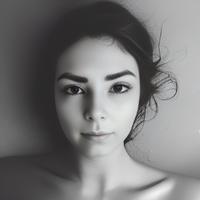 Tina Moretti
Tina MorettiTina Moretti, a passionate hair care enthusiast with over a decade of expertise, dedicates herself to empowering women with proven hair care advice. Recognized for her hands-on experience and trusted guidance, Tina turns every strand into a statement of beauty and confidence.